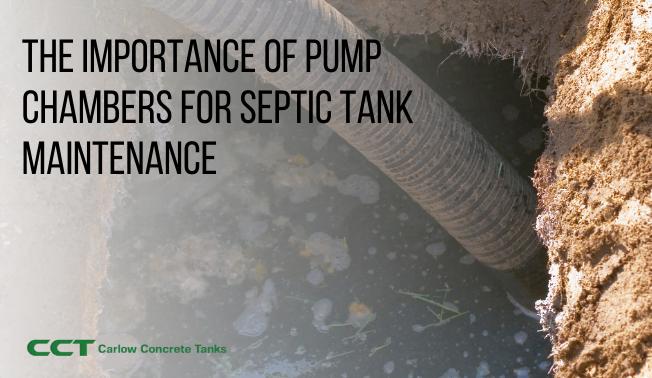A basic septic tank is comprised of the tank, the drain field and the soil, however more sophisticated tanks now feature a pump chamber and overflow tank. In this blog, we look at the important role pump chambers play in septic tank maintenance.
What is a pump chamber?
A pump chamber is used to disperse the effluent when your site has a high-water level or if the gradients for drainage are unfavourable. When the effluent in the pump tank rises to a level determined by a control float, the pump activates and pumps the effluent until it reaches a level that switches the pump off.
It’s important that your pump chamber is working efficiently as if it malfunctions then your septic tank may shut down completely.
Importance of the pump chamber
The pump chamber is one of the most important components of a septic tank that is most often made from concrete. The chamber is installed after the septic tank and contains an alarm float for high water, pump control floats and a pump. The control floats can be adjusted to pump a certain volume of effluent.
A fully functional pump chamber will disperse effluent from your septic tank to the drain field where it will no longer be classified as an environmental hazard. Without this vital component, effluent will not move freely and effectively through your septic tank system and in worse case scenarios effluent can back up into your home.
Issue alerting
Once the effluent gets as high as the on float, the pump will send the effluent to the drain field. The pump will continue until the level of effluent has dipped to the low level of the off float. If the pump malfunctions i.e. if the effluent gets higher than the on pump due to the control float not activating, the alarm float will notify you to allow you to correct the issue before it worsens. While the issue waits to be resolved any further effluent that enters the pump tanks is moved into the overflow tank which is an additional storage space. This provides you with the opportunity to solve the issue before effluent backs up into your home.
Maintenance
The pump chamber is responsible for sending effluent to the drain field. If the pump chamber malfunctions, the entire septic system can stop working properly. Once the overflow tank fills, effluent will begin to back up within the septic tank and could make its way back into your home. To avoid these issues, it’s important for septic tank maintenance that proper care is taken of the pump chamber. The pump chamber should be inspected once a year. Any electrical components should also be checked for signs of corrosion.
Final destination
As long as the pump chamber is operating as it should then the final step it takes is to pump effluent through a layer of gravel before finally reaching the drain field. The drain field is where the effluent receives its final phase of treatment thanks to the organisms in the soil.
Contact us to learn more
Carlow Concrete pump chambers can accommodate most practical capacities. We have developed a range of standard configurations to simplify specifying the right combination.
An engineering design service is provided where unusual site conditions require a more detailed investigation. These products are highly cost effective and are particularly suited to difficult sites where ground conditions are such that conventional construction methods are inefficient or attract additional risk. We are a fixed cost supplier.Please contact our experts today to discuss the specific details about our pump chambers. Email enquiries to sales@carlowtanks.com, or call +353 59 9159100. You can also find out how pump chambers work here.

